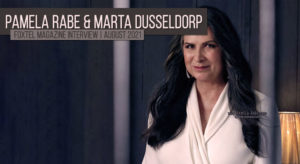Cartoonist Jules Feiffer took the techniques of his satirical art and applied them to the stage when he wrote ‘Little Murders‘ in the late sixties. As in caricature, he began with common human foibles and enlarged and exaggerated them to the point where they became both hilarious and devastating.
He is said to have predicted the Me Generation and was the first of the humorists, like Woody Allen and Gary Trudeau, to exploit the neuroses, fears and alienation of the “urban beast” living with the constant assault on the senses in a big city.
Pamela Rabe hams it up in preparation for her role as an all-american daughter in “Little Murders”
Although the play is now regarded as one of the greatest American comedy of the 20th Century, it closed after four shows when it first opened in New York in 1967. Pamela Rabe, the Canadian-born actress and winner of the Green Room award for Best Actress in ‘Gertrude Stein and Companion‘, plays the all-American daughter Patsy. She says that Feiffer’s vision of random violence as a part of everyday life was too close to the bone. Although it received many awards it “got slammed in the press”.
“It was just too tough. New Yorkers did not see their city that way. That’s why it was spot on. He could pick out what people didn’t want to confront or face. I think it will be interesting to see how Melbourne takes it because we are also living in a city where Hoddle and Queen Street happen.
“He put his finger on something that was happening in the States, certainly from the point when Kennedy was assassinated, when suddenly the thought of random violence began to take over people’s lives. All the stories about living in New York city where people were being mugged and raped on the footpaths and people are walking by and turning their heads away — the stuff that is New York city or the myth of New York city,” she says.
In ‘Little Murders’, Jules Feiffer constructed a kind of social experiment: he began with reality and took it to an extreme. The play revolves around a crazy, all-American family who literally have to dodge the snipers’ bullets when they go out to get the groceries. Every time a window is opened sirens and the chaotic noises of the street. can be heard.
“Feiffer zeroes in on people’s different ways of coping with violence. Patsy is the extreme end of positivism like Wonder Woman or Miss America, and Alfred her fiance is beyond pessimism, just nihilism.” The conflict, she says, arises out of their polarised ways of dealing with this metropolitan madness.
Pamela Rabe says that even though she is playing a larger than life character she believes that people will be able to see elements of their own relatives or acquaintances in Patsy. “The style of it demands that everything is grounded in truth. They become like clowns or cartoons. You see how it relates to you and then you can laugh at it. It’s hilarious but it’s also very black. He is dealing with people gunning people down in the street.“
Although ‘Little Murders’ was initially condemned in New York it had a highly successful season in London at about the same time. Pamela Rabe suspects that outsiders can more readily accept the play because it fits their image of New York as a mean and crazy city. But, she adds, if the MTC is doing its job properly, the audience should feel that such a scenario is not limited to New York.
“I remember right after Hoddle Street how our senses were traumatised. I’d get on the tram going to work and think ‘Oh God, that person could pull a rifle out. What if that bag over there is a bomb?’ That’s in a sense what Feiffer is doing. He’s making that the reality and showing how people cope with that.“
Fiona Capp
Source: The Age | 10 February 1989



